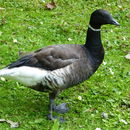ar
الأسماء في صفحات التنقل


Much smaller (22-26 inches) than most Canada Geese (Branta canadensis), the Brant’s gray back also makes it much darker than its larger relative. Whereas Canada Geese have a large white “chinstrap,” the Brant has a much smaller white patch on its black neck. This species may also be identified by its black chest, white breast, and light gray flanks. The Brant is widely distributed across the Northern Hemisphere. In North America, this species’ breeding range is restricted to coastal areas in northern Alaska, Greenland, and arctic Canada. Most Brant breeding in North America winter along the Pacific coast of the United States or in the Mid-Atlantic region, while those that breed in northeastern Canada and Greenland winter in Europe. In the Old World, Brant breed in Siberia and winter to Western Europe and East Asia. In summer, Brant breed near salt marshes, in river deltas, or on small islands near shore. During the winter, this species inhabits estuaries, mudflats, and protected bays. Brant primarily eat mosses and small non-woody plants on their breeding grounds; during the winter, this species subsists almost exclusively on eelgrass, a type of submerged seagrass. Due to the inaccessibility of their breeding grounds, most birdwatchers never observe Brant during the summer months. They are much more accessible in winter and during migration, when they may be found singly or in flocks on large coastal bodies of water. This species is primarily active during the day.